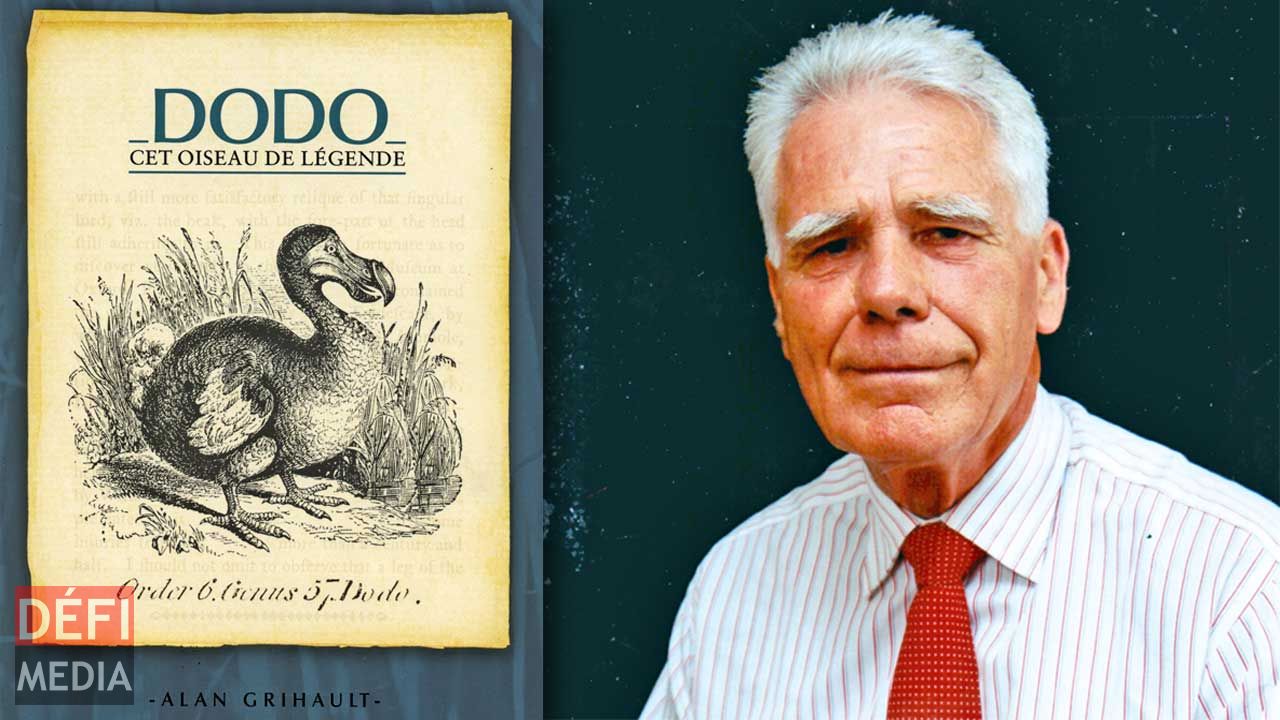
British born Alan Grihault presented this week a French translation of his book ‘Discovering the Dodo.’ Readers will be able to learn how the Dodo was discovered, how it lived, what it looked like and how it died here thus giving Mauritius notoriety all over the world.
Publicité
 Everybody talks of the Dodo as an extinct bird but no-one says how it reached Mauritius. Alan Grihault writes in his book that “a team from Oxford University managed to extract a soft part from inside the claw of a Dodo from the Oxford University Museum of Natural History. This confirmed that the Dodo was a large pigeon resembling much the Nicobar pigeon which still lives on that island to the east of India.” A specimen of the Nicobar pigeon can be seen at the Casela Nature Park.
Everybody talks of the Dodo as an extinct bird but no-one says how it reached Mauritius. Alan Grihault writes in his book that “a team from Oxford University managed to extract a soft part from inside the claw of a Dodo from the Oxford University Museum of Natural History. This confirmed that the Dodo was a large pigeon resembling much the Nicobar pigeon which still lives on that island to the east of India.” A specimen of the Nicobar pigeon can be seen at the Casela Nature Park.
The saying goes – ‘As dead as the Dodo.’ But to-day science has made much progress and has brought a revolution in the study of DNA of living and dead creatures. This gives way to speculation that maybe someday the Dodo could be revived through its DNA. Unfortunately Oxford University scientists declare that the Mare aux Songes specimen brought to light are not good DNA, as they remained under water for more than 4,000 years.
How did the world learn of the existence of the Dodo? The first navigators arriving on the island were Portuguese. They named it ‘Isla de Cirné,’ or Swan Island most probably because of the large bird they found here. Afterwards came the Dutch in 1598 when their expedition en route to India was caught in a storm and five ships sighted land which their map called Isla do Cirné. Hungry shipmates caught a few dodos which they ate. Several other landings were made by Dutch explorers at the beginning of the 17th century. They wrote in their journals of the dodo, making sketches and giving different names to the bird which they found in large numbers and which provided with meat.
 Travellers too gave ample details of the bird in their diaries – Sir Thomas Herbert, a British who visited Mauritius in 1628 wrote a book about his travels around the world which was published in 1634. In the book is a drawing of the dodo with a description.
Travellers too gave ample details of the bird in their diaries – Sir Thomas Herbert, a British who visited Mauritius in 1628 wrote a book about his travels around the world which was published in 1634. In the book is a drawing of the dodo with a description.
French traveller Francois Cauche visited Mauritius, Rodrigues and Madagascar in 1638. He was the first eyewitness to have written on the dodo’s nest. “The Dodo only lays one large white egg on a heap of grass on the ground in the woods,” he wrote.
The dodo appeared also in books as early as 1865. The most famous and probably the earliest book to mention the dodo is ‘Alice in Wonderland’ created by Reverend Charles Dodgson who wrote under the pen-name Lewis Carroll.
How the dodo got extinct, nobody can say for sure but many tried to look for bones and remains. Luckily a few museums did preserve some bones. It was only in 1860 that haphazardly a young British engineer by the name of Harry Higginson, who was helping in the construction of a new railway line from Curepipe to Mahebourg, went to oversee works at the Mare aux Songes when he noticed some labourers removing soil from a muddy area. They were separating and placing into heaps a number of bones of various sorts. He stopped and picked a few bones which he kept and later brought them to George Clark, an English school teacher of Mahebourg who was looking for dodo remains around the island. He confirmed that the bones were of the dodo. This created a craze among the inhabitants. Etienne Thirioux, a hairdresser of Port Louis explored many caves and rivers of the town and he was fortunate to find near the foot of Le Pouce Mountain a complete skeleton of the dodo which can be seen to-day in the Natural History Museum of Port Louis.
How is it that Alan Grihault got fascinated with the Dodo?
“In 2001 I brought my niece to the library to show her a picture of the dodo. Nothing was found. This is how I started to conduct some research and I came out with an illustrated book for children and another one with historical facts for adults.”
There is an international auction of dodo bones announced for the coming weeks. Alan Grihault is of the view that Mare aux Songes should become a World Heritage Site and a Dodo Trail created for Mauritians and foreign visitors so that they get a factual knowledge of the extinct bird. As for the bones to be put on auction, they may have been sent abroad by George Clark during the second part of the 19th century when he was a teacher on the island, Alan Grihault told News on Sunday.

Notre service WhatsApp. Vous êtes témoins d`un événement d`actualité ou d`une scène insolite? Envoyez-nous vos photos ou vidéos sur le 5 259 82 00 !





















